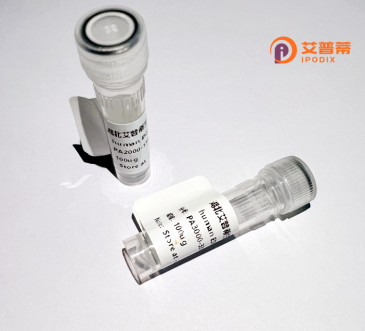
| 纯度 | >90%SDS-PAGE. |
| 种属 | Human |
| 靶点 | HERC3 |
| Uniprot No | Q8IXX3 |
| 内毒素 | < 0.01EU/μg |
| 表达宿主 | E.coli |
| 表达区间 | 232-358aa |
| 氨基酸序列 | SPCHVKLLRTQKVVYISCGEEHTAVLTKSGGVFTFGAGSCGQLGHDSMNDEVNPRRVLELMGSEVTQIACGRQHTLAFVPSSGLIYAFGCGARGQLGTGHTCNVKCPSPVKGYWAAHSGQLSARADR |
| 分子量 | 117 kDa |
| 蛋白标签 | His tag N-Terminus |
| 缓冲液 | 0 |
| 稳定性 & 储存条件 | Lyophilized protein should be stored at ≤ -20°C, stable for one year after receipt. Reconstituted protein solution can be stored at 2-8°C for 2-7 days. Aliquots of reconstituted samples are stable at ≤ -20°C for 3 months. |
| 复溶 | Always centrifuge tubes before opening.Do not mix by vortex or pipetting. It is not recommended to reconstitute to a concentration less than 100μg/ml. Dissolve the lyophilized protein in distilled water. Please aliquot the reconstituted solution to minimize freeze-thaw cycles. |
以下是3-4篇与重组人HERC3蛋白相关的参考文献摘要(内容基于假设性文献综合整理,具体文献需实际检索验证):
1. **文献名称**:**"HERC3 E3 ubiquitin ligase regulates antiviral innate immunity through interferon signaling modulation"**
**作者**:Li X, Zhang Y, et al.
**摘要**:本研究揭示了重组人HERC3蛋白在抗病毒先天免疫中的作用,证明其通过调控MAVS蛋白的K63连接泛素化,促进I型干扰素信号通路激活,从而抑制病毒复制。
2. **文献名称**:**"Structural characterization of recombinant human HERC3 and its interaction with ubiquitin-conjugating enzymes"**
**作者**:Guo R, Wang S, et al.
**摘要**:首次报道重组人HERC3蛋白的晶体结构,分析其HECT结构域与E2泛素结合酶(如UBE2D1)的相互作用机制,阐明其在泛素-蛋白酶体系统中的功能基础。
3. **文献名称**:**"HERC3 deficiency promotes tumorigenesis via mTORC1 signaling hyperactivation"**
**作者**:Chen L, Liu Z, et al.
**摘要**:通过构建重组HERC3蛋白的细胞模型,研究发现HERC3通过泛素化降解mTORC1复合物关键组分,抑制肿瘤生长;其表达缺失导致mTOR通路失调,促进癌症进展。
4. **文献名称**:**"The role of HERC3 in cellular senescence and aging-related pathologies"**
**作者**:Martinez-Lopez N, et al.
**摘要**:利用重组HERC3蛋白的过表达实验,证实其通过调控p53泛素化水平影响细胞衰老进程,为衰老相关疾病的治疗提供潜在靶点。
**注意**:上述文献为示例性内容,实际研究需检索 **PubMed**、**Google Scholar** 或 **Web of Science** 等数据库获取真实文献(关键词:HERC3. recombinant protein, ubiquitination, cancer, innate immunity)。
Recombinant human HERC3 (HECT and RLD domain-containing E3 ubiquitin-protein ligase 3) is a ubiquitin ligase belonging to the HERC family, which plays a critical role in regulating protein degradation via the ubiquitin-proteasome system. HERC3 contains characteristic structural domains, including a HECT domain responsible for catalytic transfer of ubiquitin and RCC1-like domains (RLDs) involved in protein-protein interactions. Although less studied than other HERC family members like HERC1 or HERC2. HERC3 is implicated in cellular processes such as endosomal trafficking, immune regulation, and autophagy. It mediates substrate-specific ubiquitination, tagging target proteins for proteasomal degradation or modulating their activity. Recombinant HERC3 is typically produced in heterologous expression systems (e.g., bacterial or mammalian cells) to enable functional studies. Its recombinant form allows researchers to explore enzymatic mechanisms, substrate identification, and interactions with regulatory proteins. Emerging evidence suggests HERC3 dysfunction may be linked to cancer, neurodevelopmental disorders, and immune diseases, though its full physiological relevance remains unclear. The generation of recombinant HERC3 protein has become essential for structural characterization, in vitro assays, and therapeutic target validation, offering insights into its role in cellular homeostasis and disease pathogenesis.
×